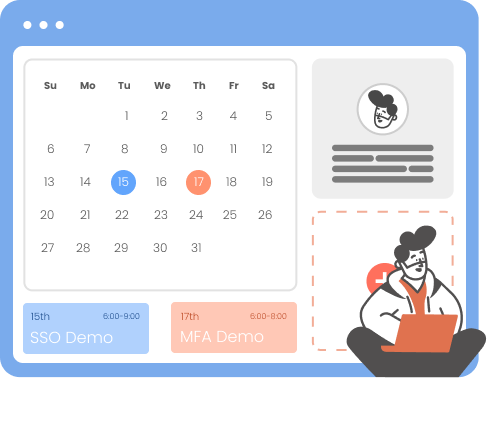How to Prevent External File Sharing in OneDrive and SharePoint
Learn how to take full control of external file sharing in OneDrive and SharePoint with CASB security. Get actionable strategies, real-time monitoring tools, and automated policies to protect sensitive data and meet compliance standards.
With the growing adoption of Microsoft 365 for hybrid and remote work, platforms like OneDrive and SharePoint have become essential for collaboration. However, if external file sharing is not properly controlled, it can expose sensitive business data and lead to serious compliance violations.
While Microsoft offers some native security capabilities, they often fall short of the real-time control and contextual enforcement needed in today’s cloud environments. miniOrange Microsoft 365 CASB for Cloud App Security can help fill this gap by delivering advanced protection across SharePoint, OneDrive, and other Microsoft apps.
Let's explore how to prevent unauthorized external sharing using CASB best practices, granular policies, and proactive monitoring.
Why External File Sharing Control Matters?
External file sharing in OneDrive and SharePoint Online is often essential for collaboration with clients, vendors, and external stakeholders. However, unrestricted sharing can pose significant risks, especially when sensitive data like contracts, intellectual property, or financial documents is exposed to unauthorized recipients. Microsoft 365's native controls may not provide the real-time visibility, policy enforcement, or alerts needed for high-stakes security and compliance environments.
Here's why controlling external file sharing is critical:
- Data breaches from unauthorized external access due to shared links or misconfigured guest access.
- Non-compliance with data protection laws like GDPR, HIPAA, or SOC 2, which require strict access controls and data usage logging.
- Lack of audit trails and visibility, Microsoft's native sharing reports are delayed and often miss user context or intent.
- Reputational and legal risks from accidental leaks of internal or confidential files.
How miniOrange CASB Closes the Security Gaps Left by Microsoft 365 Native Controls?
1. Real-Time Monitoring
- Microsoft 365 Native: Delayed audit logs make it difficult to detect threats and respond in real time, leaving your organization exposed to potential data breaches or insider risks.
- miniOrange CASB: Offers real-time visibility across Microsoft 365 applications like SharePoint and OneDrive, instantly detecting unauthorized file access, unusual sharing patterns, and risky login behaviors. This enables IT teams to identify threats early and prevent data breaches or compliance violations.
To explore how CASB auditing enhances security posture and supports incident response, check out our detailed guide on CASB auditing.
2. Granular Sharing Control
- Microsoft 365 Native: Offers basic, static sharing policies that lack adaptability to real-time risk factors or user context.
- miniOrange CASB: Enables dynamic, fine-grained control over file sharing in Microsoft 365 apps like SharePoint and OneDrive. Admins can create sharing rules based on user roles, device compliance status, file sensitivity levels, geolocation, and more that protect data without disrupting collaboration.
For advanced protection across the Microsoft ecosystem, explore how miniOrange CASB secures Microsoft 365 cloud apps and enhances Microsoft Teams security through contextual access control.
3. Auto-Revoke External Access
- Microsoft 365 Native: Relies on manual processes to revoke external access, increasing the risk of prolonged data exposure after access is no longer required.
- miniOrange CASB: Delivers automated external access revocation across Microsoft 365 apps like SharePoint and OneDrive. Access is instantly revoked based on inactivity, policy violations, or real-time risk signals, compliance, and reducing data leakage windows.
4. No Advanced Threat Detection with UEBA
- Microsoft 365 Native: Provides limited threat alerts and lacks built-in User and Entity Behavior Analytics (UEBA), reducing its ability to detect insider threats or advanced persistent risks.
- miniOrange CASB: Utilizes UEBA to continuously monitor user activities across Microsoft 365 apps like SharePoint, OneDrive, and Teams. By detecting behavioral anomalies, such as mass file downloads, irregular login times, or device mismatches, it enables early threat detection and faster incident response.
Learn how UEBA-driven CASB security also enhances visibility across platforms like ServiceNow, helping organizations unify threat response across the cloud.
5. Shadow IT Visibility
- Microsoft 365 Native: Offers limited insight into unauthorized third-party apps and unsanctioned tool usage, leaving organizations exposed to unmanaged risks.
- miniOrange CASB: Delivers complete Shadow IT visibility in Microsoft 365 by continuously monitoring cloud app traffic and identifying unsanctioned third-party tools. It helps organizations detect risky apps, flag non-compliant usage, and enforce smart access controls to prevent data leaks.
To see how it works in action, watch this quick demo on Shadow IT detection.
6. Unified Visibility Dashboard
- Microsoft 365 Native: Restricts visibility to individual tools like SharePoint and OneDrive, making it harder to monitor organization-wide activity.
- miniOrange CASB: Delivers a centralized security dashboard that consolidates alerts, audit logs, and access policies across Microsoft 365, Google Workspace, Dropbox, and other cloud platforms. This unified view helps IT teams monitor threats and enforce security policies efficiently across environments.
To explore how this works specifically within Microsoft's ecosystem, check out our detailed blog on Microsoft Office 365 CASB Security.
Real-World Scenario: How CASB Prevents Risky External Sharing in OneDrive and SharePoint
Imagine a marketing team member in your organization uploads a confidential campaign strategy document to OneDrive and unknowingly shares it with their personal Gmail account for easy access at home.
Without a CASB
- Audit logs are delayed, limiting real-time incident response.
- If the file lacks a sensitivity label, the system might not even trigger an alert.
- The external user can access, download, or forward the document unchecked.
With miniOrange CASB
- The external file sharing event is detected in real time.
- Since the recipient domain (gmail.com) violates the organization's approved sharing policy, the share link is automatically revoked.
- An alert is sent to IT with full session details: user, IP address, time, device, and file name.
- The incident is logged in the CASB dashboard and can be exported for compliance audits (GDPR, HIPAA, ISO 27001, etc.).
This level of real-time external sharing prevention is achievable with miniOrange CASB for Microsoft 365, not with native Microsoft 365 controls alone.
How to Use miniOrange CASB to Prevent External File Sharing in Microsoft 365 (OneDrive & SharePoint)
Step 1: Sign Up and Access the miniOrange CASB Dashboard
- Click here to log in to CASB Dashboard.
- (Don't have an account? No worries, click here to create a new account.)
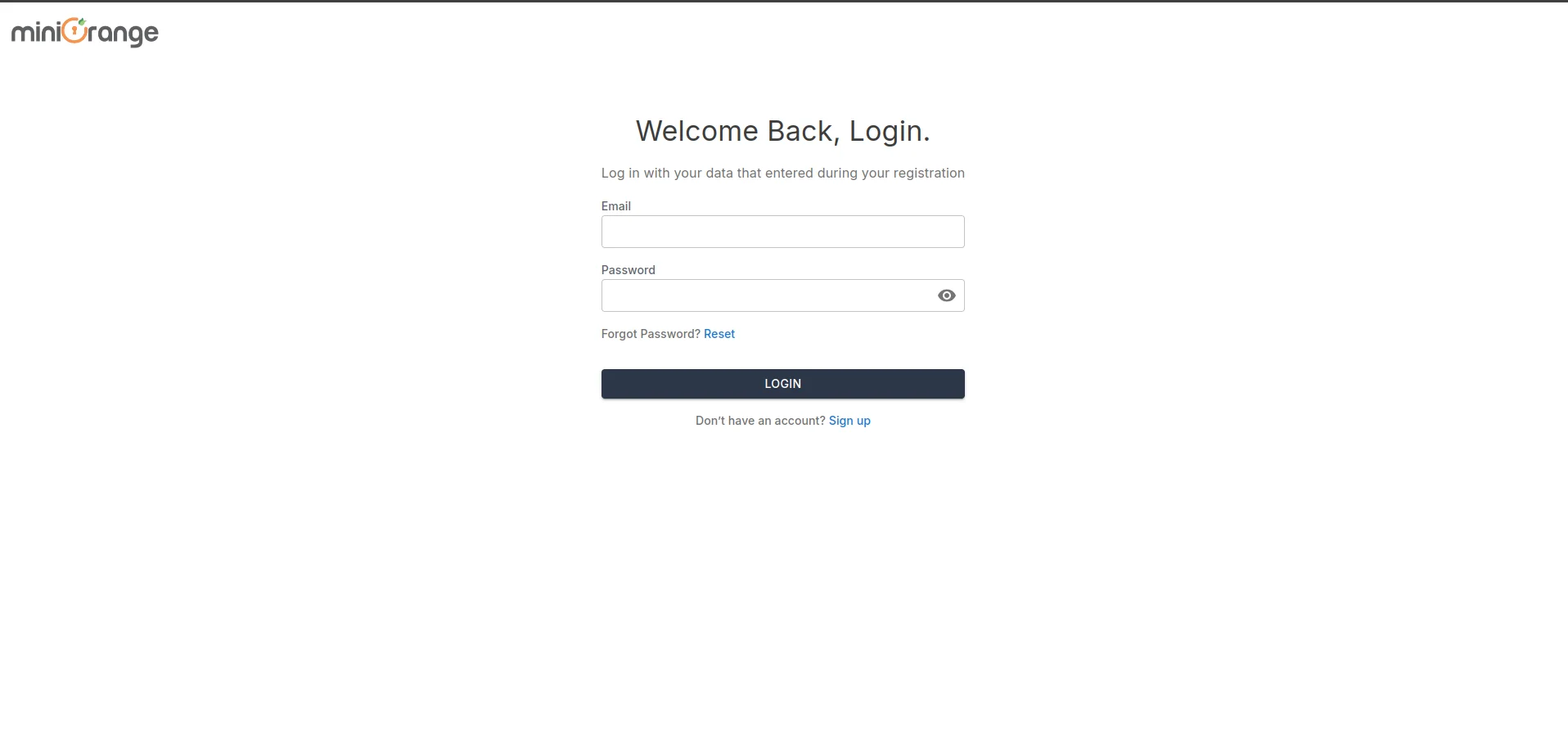
- Go to your miniOrange CASB dashboard.
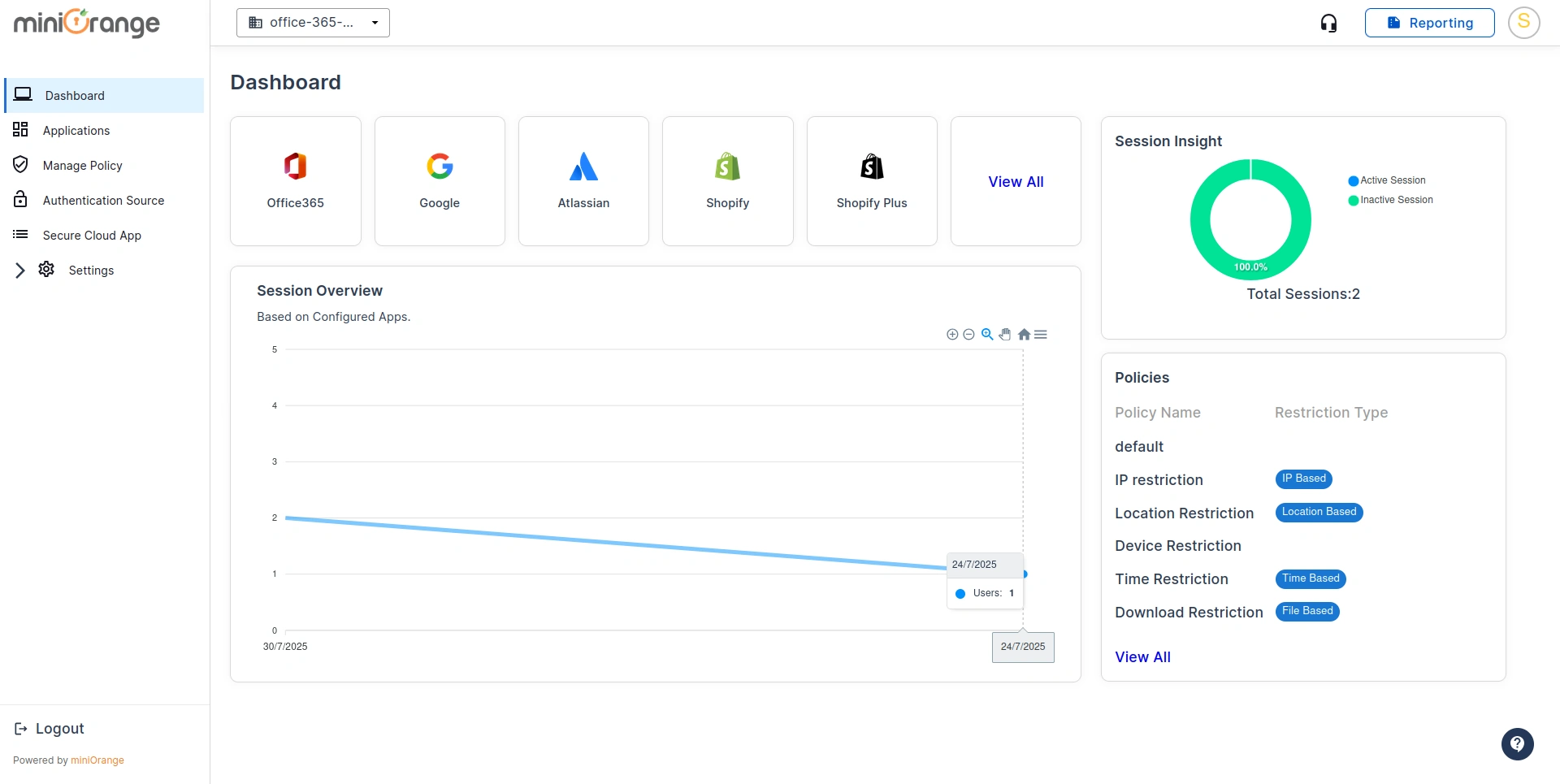
Step 2: Enable Real-Time File Download Monitoring for OneDrive & SharePoint
- Go to Manage Policy and create or select a policy with a clear name and description.
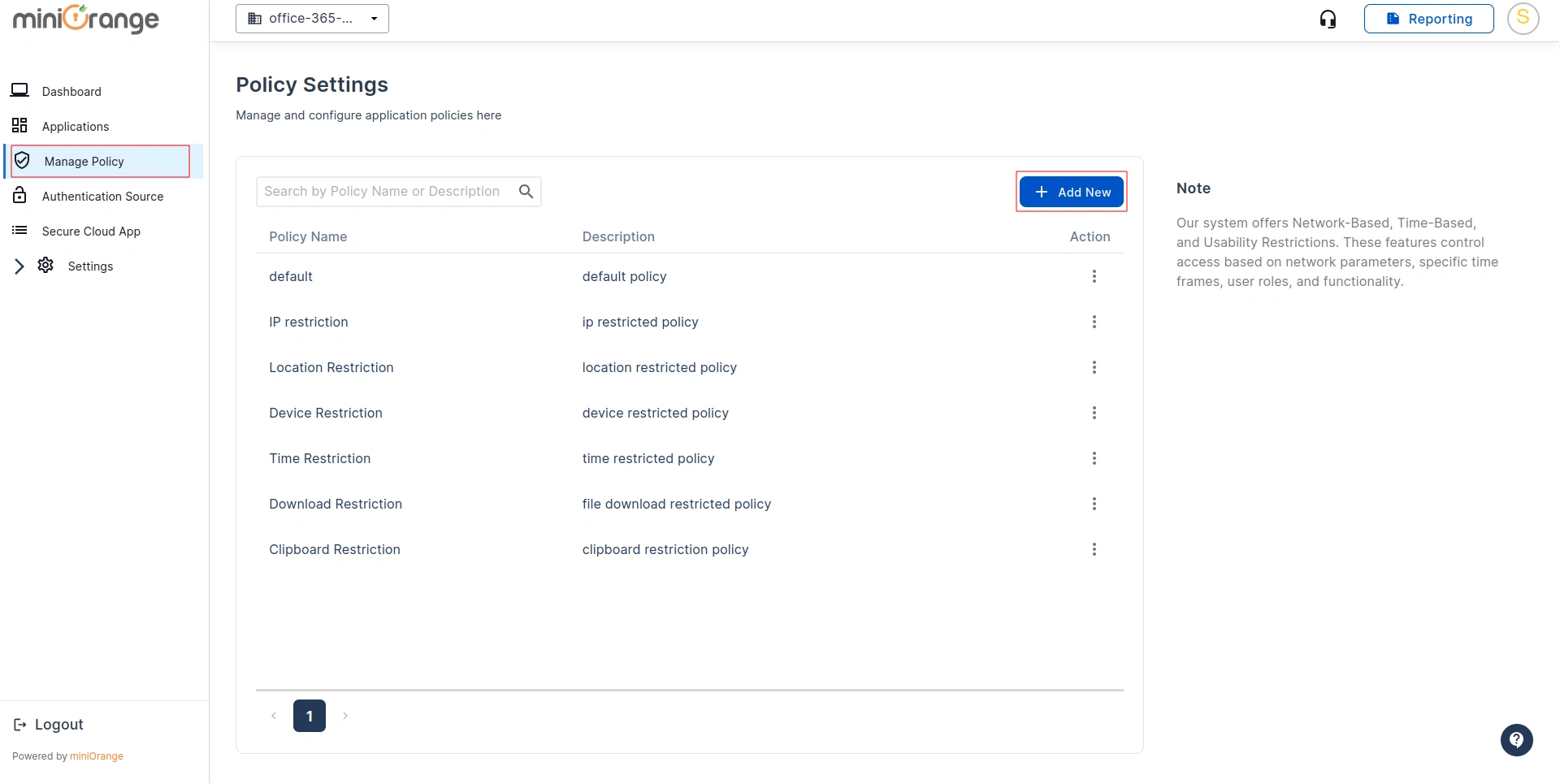
- Enable the rule to block downloading and sharing. You can also activate File-Based Restrictions to control downloads by file type (e.g., .pdf, .docx, .xls).
- Further refine access by applying policies based on user identity, device type, IP address, etc, ensuring granular control over data access and movement.
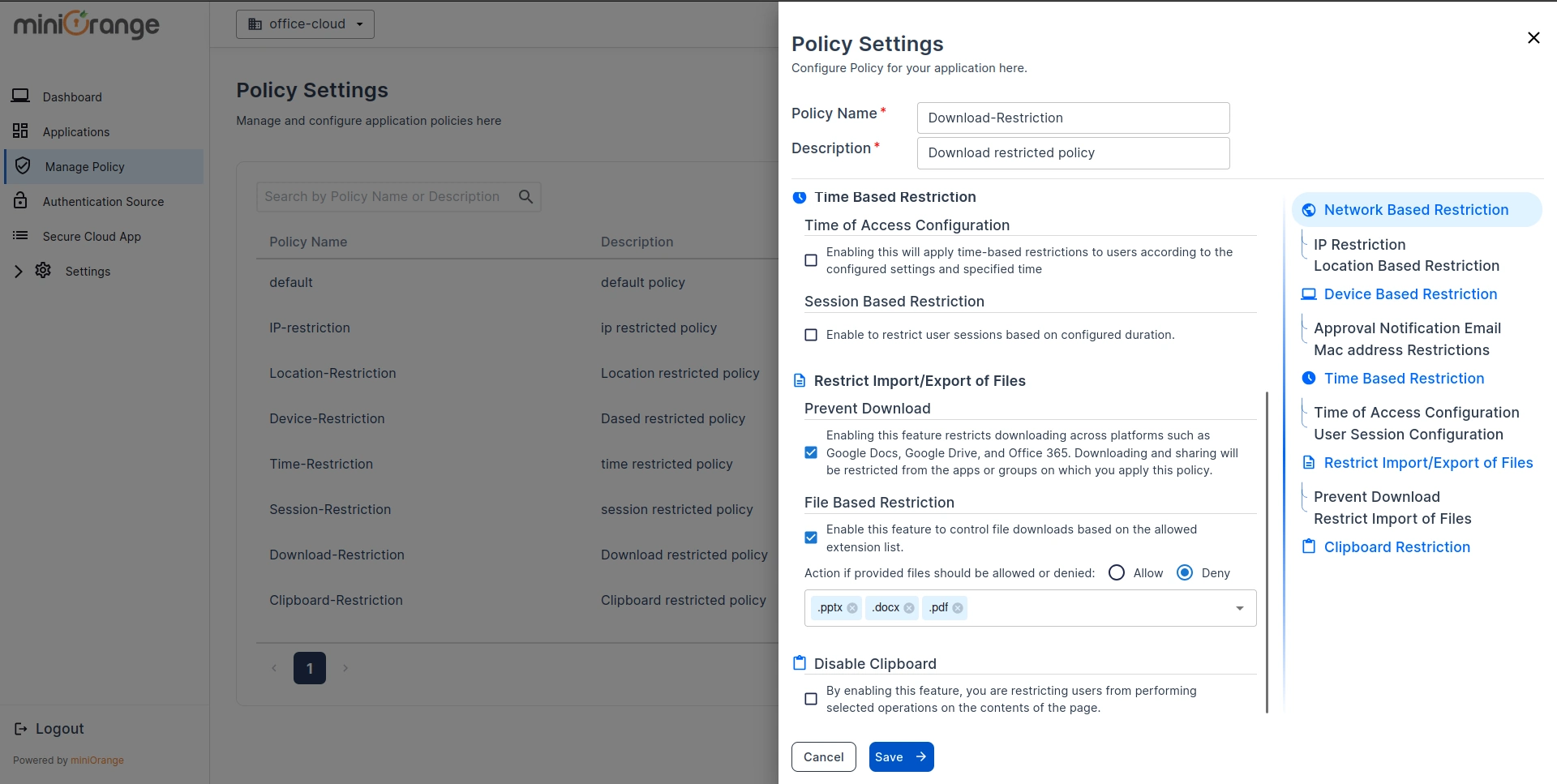
- Once configured, attach the policy to a user group of your configured application under the Applications Section to ensure the restrictions are enforced for the intended users.
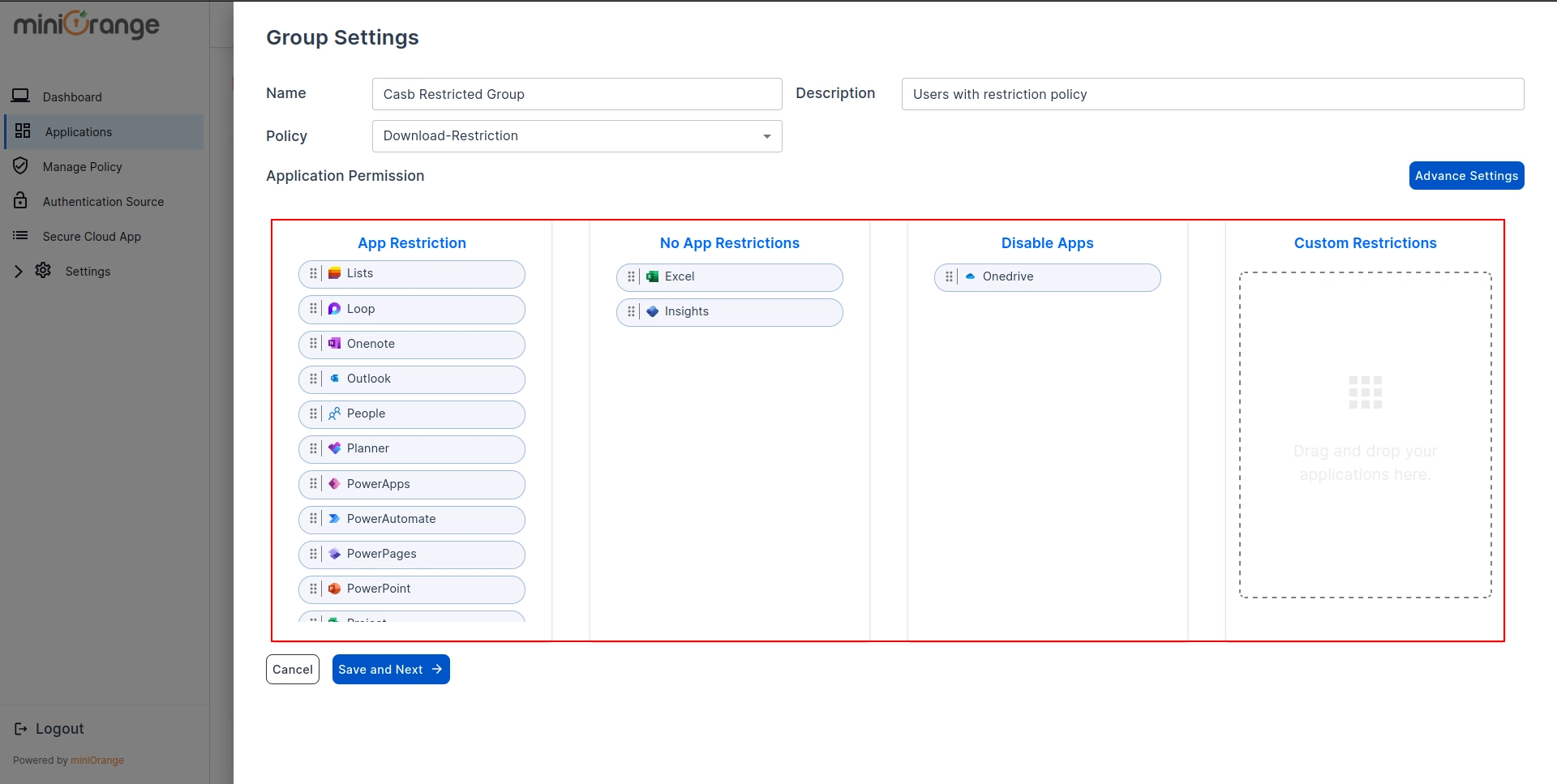
Step 3: Real-Time Alerts to IT/Security Team
- Go to Settings > Reporting > Policy Notifier.
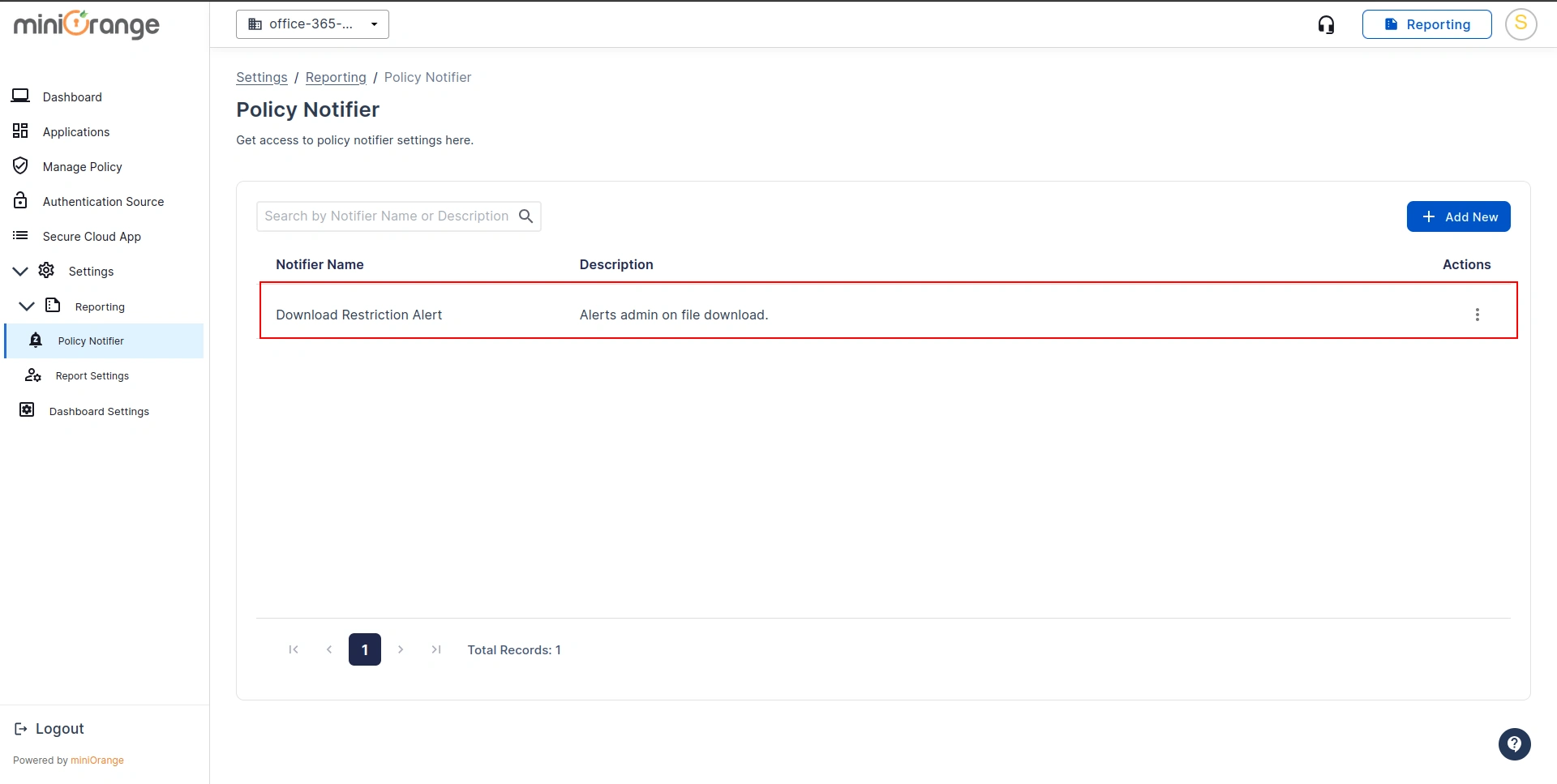
- Enable real-time email alerts to instantly notify your IT or security team whenever a user violates a policy.
- Each alert includes details like the user involved, violation type, and timestamp.
- You can also monitor all activities and violations from the Reporting Dashboard for continuous monitoring.
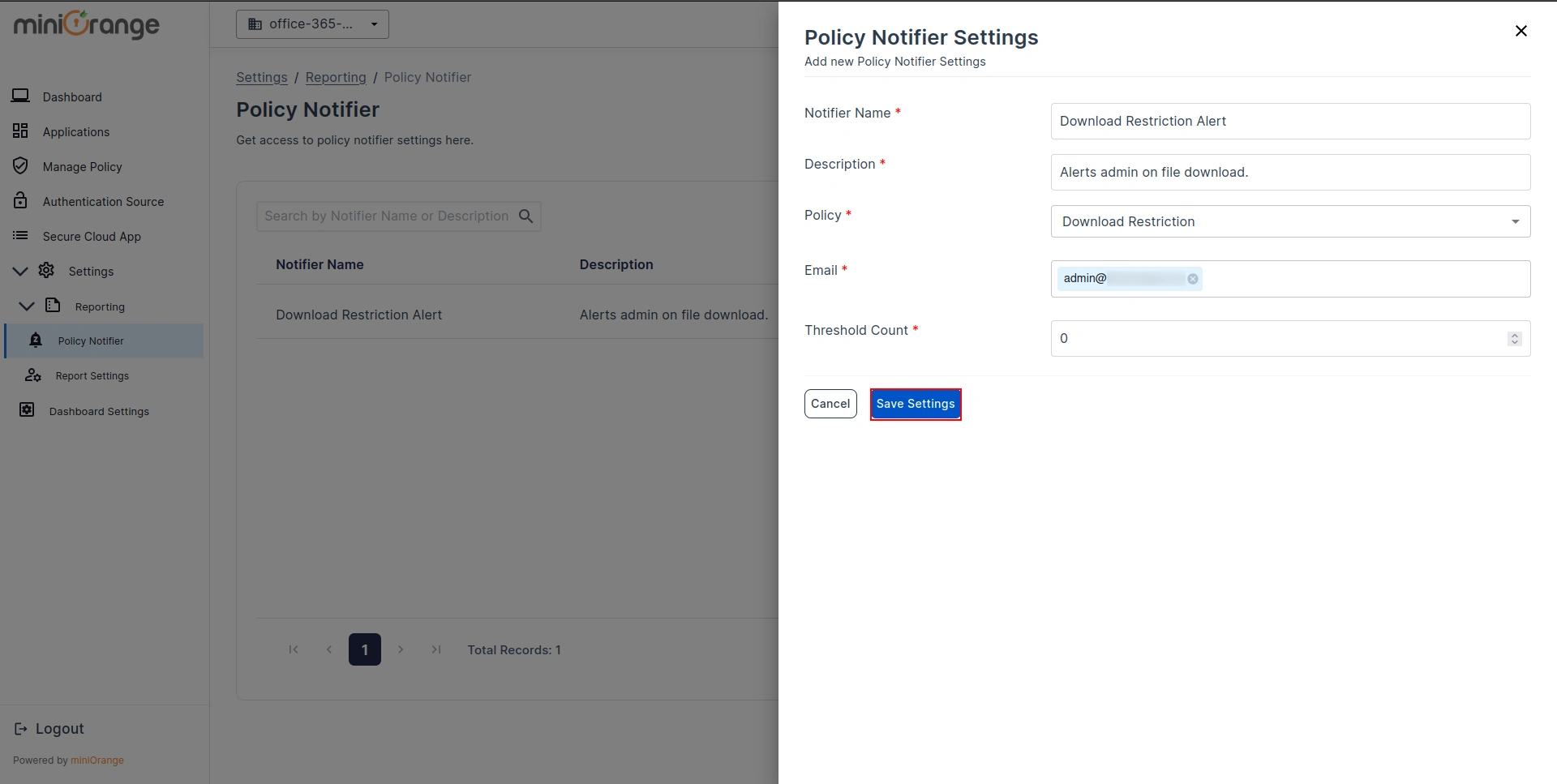
Step 4: Monitor User Activity and Export Audit Logs for Compliance
- Go to Logs > Incidents in the CASB dashboard.
- Click on User Details to view session activity, files accessed or shared, and policy violations in real time.
- Apply filters like User, File Name, or Date/Time to investigate incidents.
- Export audit-ready logs to meet compliance standards such as GDPR, HIPAA, and ISO 27001.
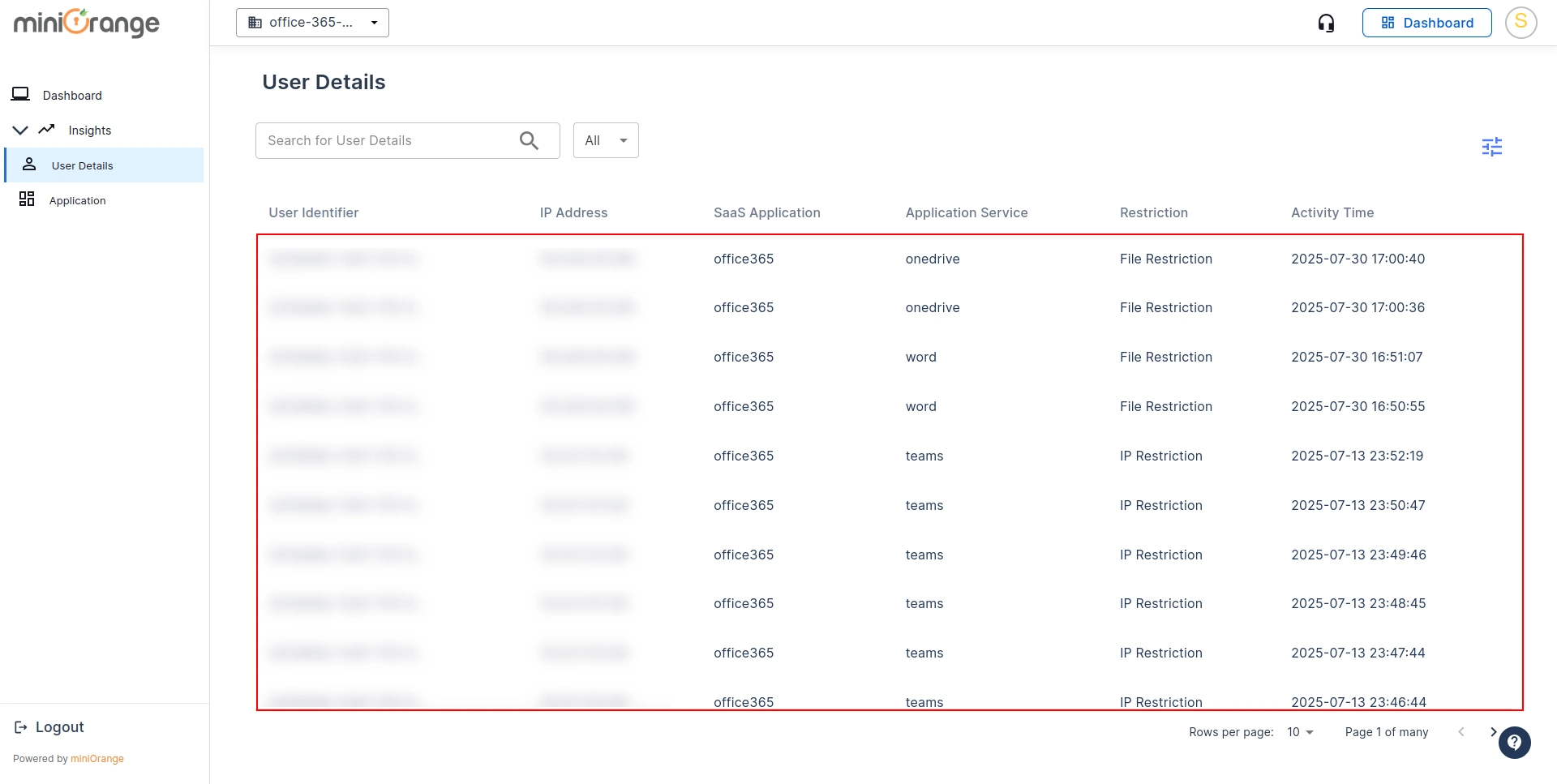
Best Practices to Secure OneDrive & SharePoint While Enabling Safe External Collaboration
1. Use Microsoft 365 Sensitivity Labels to Block External Sharing
Apply Microsoft Purview sensitivity labels (like "Confidential" or "Internal Only") to classify data, and extend their enforcement using miniOrange CASB. This ensures that sensitive files are automatically protected from unauthorized access or external sharing. This approach is already proving effective in regulated industries.See how sensitivity labels enhance data protection in healthcare.
2. Enforce Domain Restrictions Instead of Disabling Sharing Entirely
Allow external sharing only with trusted partner domains instead of blocking it completely. With miniOrange CASB, you can enforce domain restrictions to prevent file access from risky sources like personal Gmail accounts while enabling secure collaboration. Learn more in our detailed blog on how to restricting user access to Microsoft 365 (CASB + DLP + MDM + IAM).
3. Monitor and Auto-Revoke Risky File Shares with CASB Alerts
miniOrange CASB continuously monitors file-sharing activity and detects unauthorized shares to risky domains like Gmail or Yahoo in real time. Automated policies instantly revoke access, notify admins, and log session details—reducing the risk of insider threats and accidental data leaks. Learn more about SharePoint security with Microsoft 365 CASB and the role of CASB auditing in cloud data protection.
4. Educate Users with Real-Time DLP Prompts to Prevent Data Leaks
Show real-time DLP prompts when users attempt to share sensitive content—guiding them to make safer decisions, stay compliant with internal policies, and reduce accidental data leaks. Learn more about Cloud DLP and the differences between CASB and DLP here.
Compliance & Audit-Ready CASB Reporting for GDPR, HIPAA, SOC 2, and ISO 27001
With miniOrange CASB, organizations can enforce data protection policies, maintain detailed audit logs, and generate compliance-ready reports aligned with major regulatory frameworks:
1. HIPAA (Health Insurance Portability and Accountability Act)
Automatically detect and block unauthorized sharing of PHI (Protected Health Information) with real-time DLP policies to ensure healthcare data privacy.
2. SOC 2 (Service Organization Control 2)
Maintain tamper-proof audit trails, access logs, and sharing records to demonstrate that only authorized users accessed sensitive content.
3. GDPR (General Data Protection Regulation)
Monitor and log how EU resident data is shared externally. Detect and flag unauthorized file movements to stay compliant with GDPR's data transparency requirements.
4. ISO 27001 (Information Security Management System)
Enforce and monitor file-sharing policies continuously. Document risk remediation and security controls that align with ISO 27001 standards.
Summary
External file sharing in OneDrive and SharePoint can quickly become a serious security and compliance risk if not managed properly. While Microsoft 365 offers basic sharing controls, they often lack real-time protection, auto-revocation, and deep visibility. miniOrange CASB closes these gaps by enabling real-time monitoring, automatic blocking of risky shares, and UEBA-based threat detection across Microsoft 365 apps.
You can enforce domain-based restrictions, apply Microsoft Purview sensitivity labels, and show real-time DLP prompts to prevent accidental data leaks. It also offers shadow IT detection and a unified dashboard to manage file sharing, alerts, and access policies across cloud platforms. With miniOrange CASB, you get full control over external sharing in OneDrive and SharePoint, helping you stay secure, compliant, and collaboration-ready.
External References








